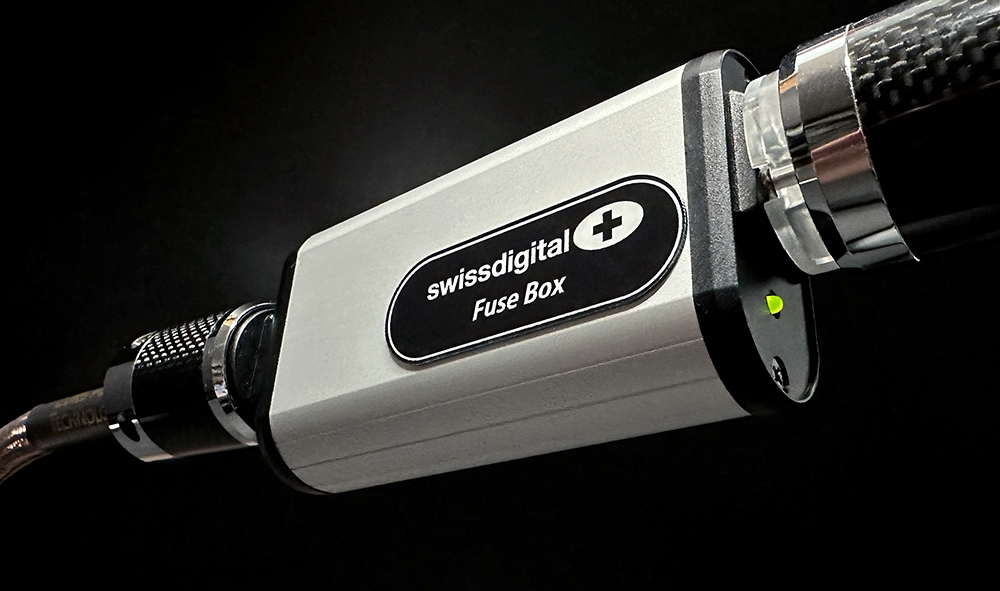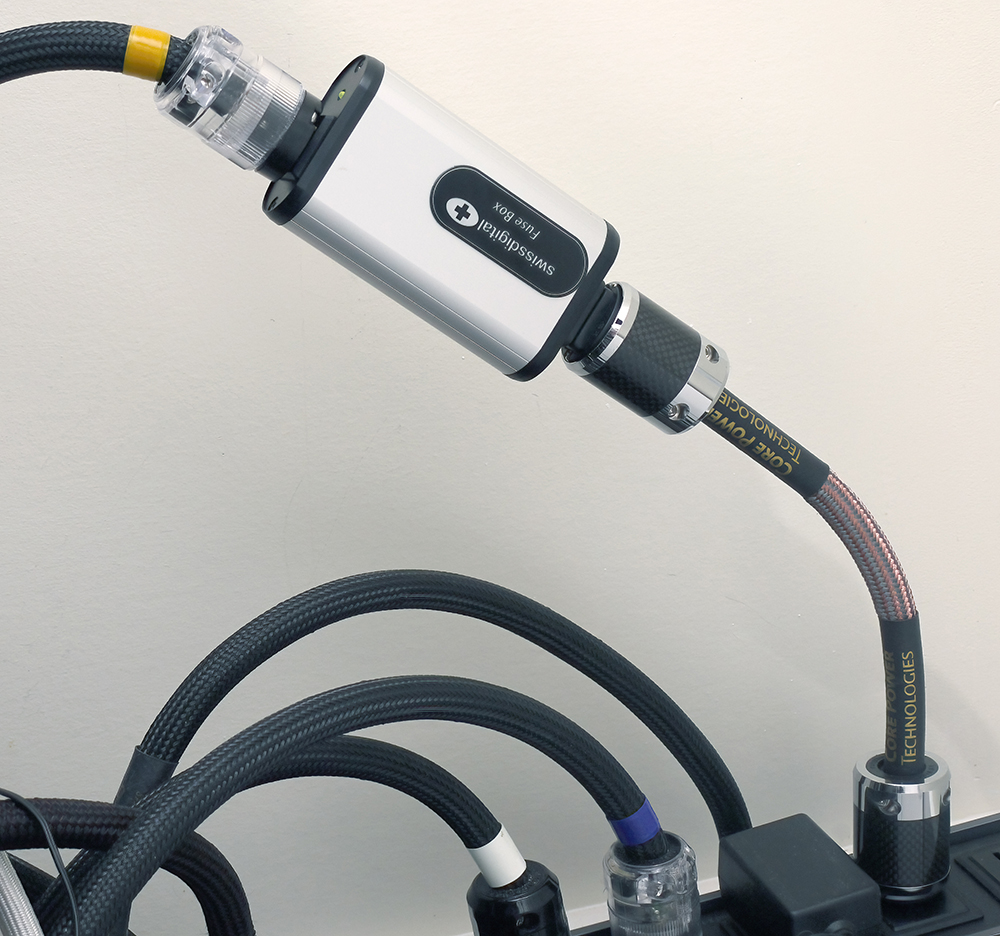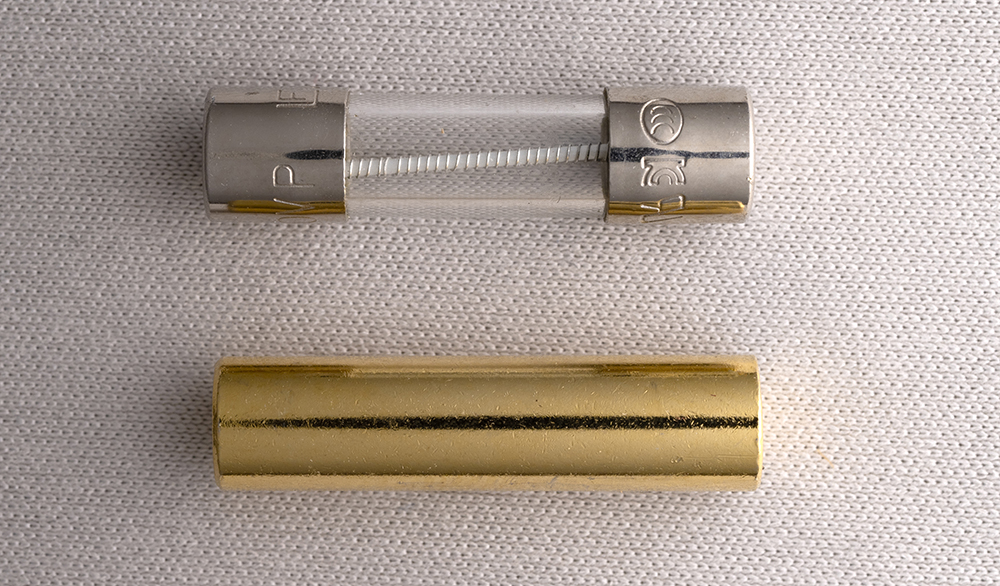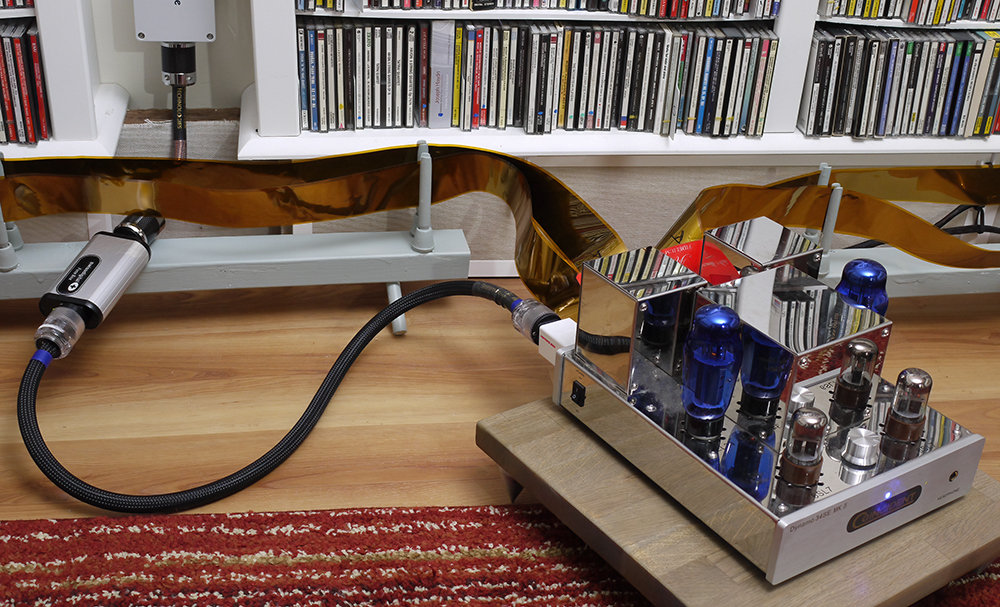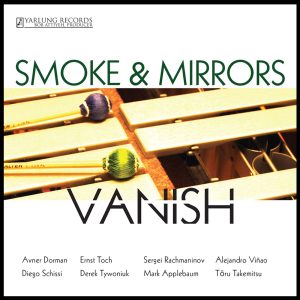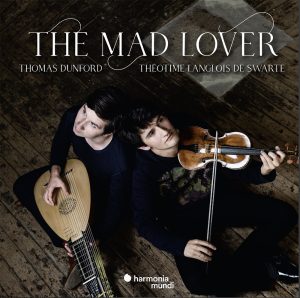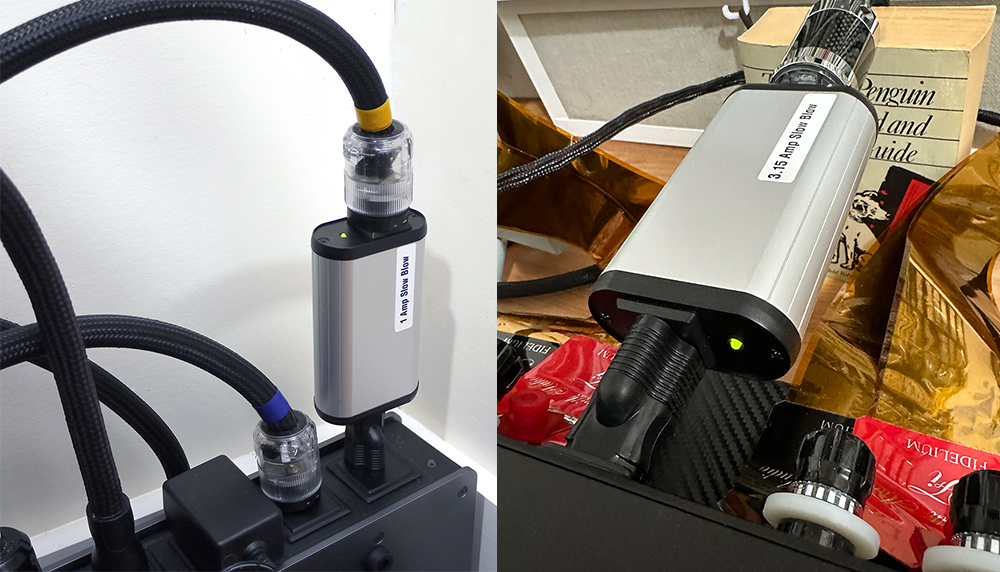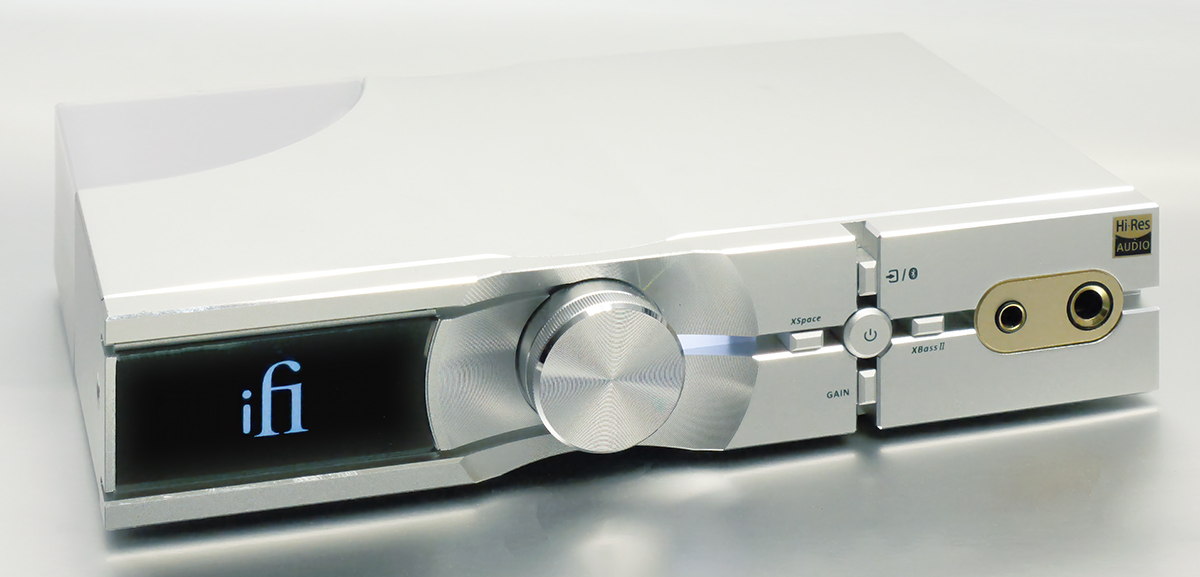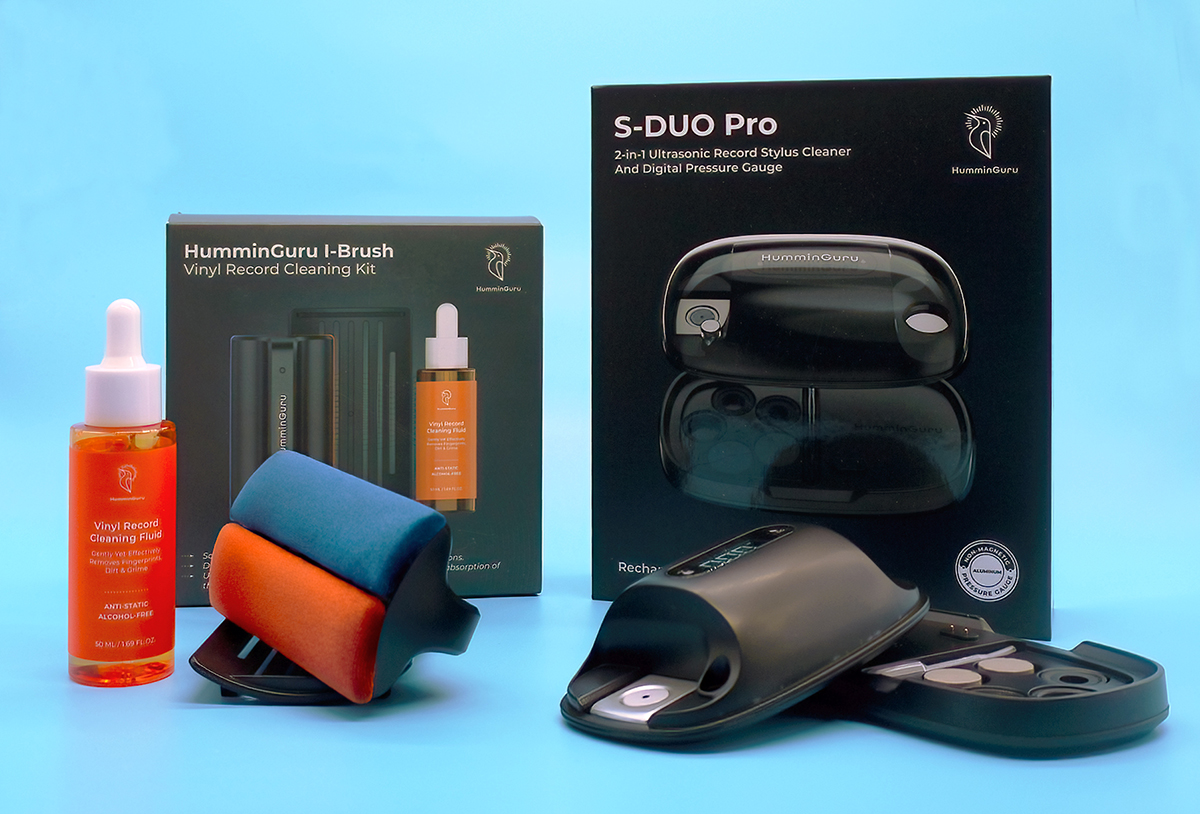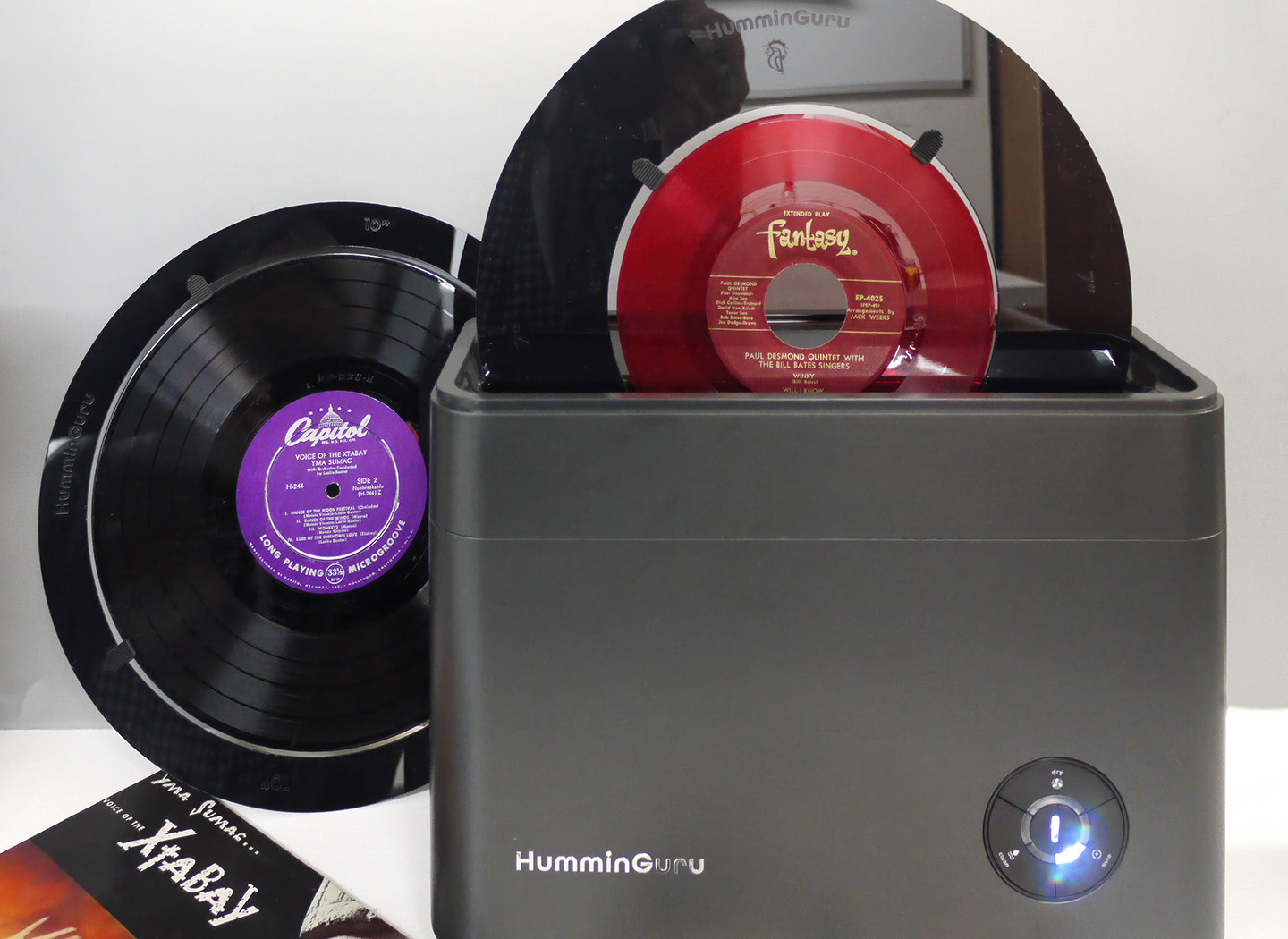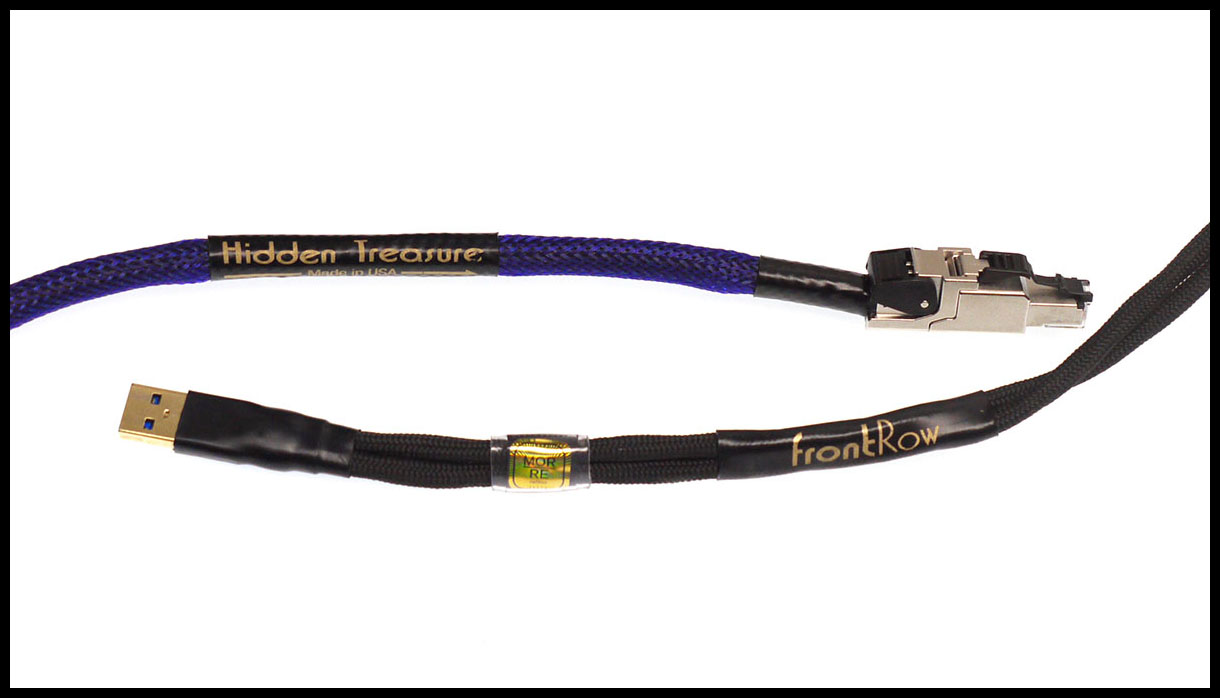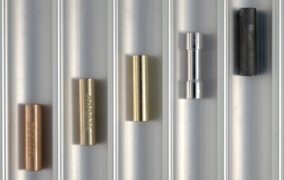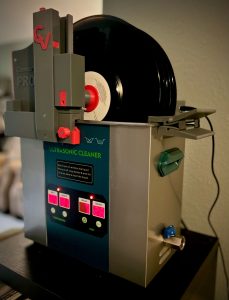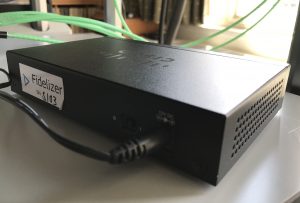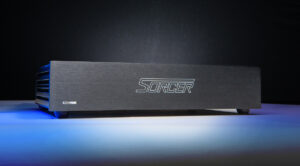A Swiss Digital Fuse Box (SDFB for short) is a $395 device that replaces the generic $2 power fuse in high performance audio gear. Yes, you read that right. It is also potentially the most disruptive audiophile add-on since…what?…the subwoofer?… the power conditioner? Sorry, but your THC gummies don't qualify.
So let us first consider the SDFB in the context of the burgeoning niche market for $200 (and higher) audiophile fuses—the suicidal safety kill-switches for which it is really intended to replace. What today we call a fuse was patented in 1890 by Thomas Edison. Then, as now, its only role was to protect electrical devices that might be susceptible to external line voltage surges (think lightning storms) or internal failures (short circuits, etc.) that might damage the equipment or just burn the house down.
The UK still puts fuses inside every AC wall plug (still lots of thatched roofs over there), while most homes in the US have long since replaced the old "fuse box" with a circuit breaker panel, and thus few domestic appliances require a fuse. Actually, lots of audio gear doesn't need a fuse either. Those little boxes with wall-wart power supplies, for example. But many "high-end" audio components have fuses, especially performance-critical components like amps, preamps, phono stages, etc.
Like that high-current amp for which you just bought a hefty and expensive power cord. Great, but check the wire element in the mass-produced fuse that sits between the IEC jack and the amp's power supply, and through which all the power needed by the amp must pass. It is intentionally so thin that a bit too much current will melt it and break the connection before anything in the amp melts instead. That fuse is probably the cheapest thing in the amp's circuit, and intentionally the weakest link.

Audiophile fuses, by contrast, are precision manufactured in small quantities and make sound quality the priority in various ways, most of which are proprietary. Hi-Fi Tuning does admit to using silver and gold, and other brands might tout great benefit from beeswax, for example. For the record, I have heard and enjoyed quite significant sonic benefits with fuses in the $20-200 range. Yet one can easily spend much more for exotic fuses, and I can only assume some further improvements are worth it. So why did I end up buying a $395 SDFB instead?
Because I had a chronic fuse problem. I've written previously of the challenges in getting my 150 sq. ft. listening room to "sound big." One key part of the quest was a BSG Technologies QØL (pronounced coal) Signal Completion Stage. I had heard it at an audio show about a decade ago, and was much impressed, not least by what it did with an ancient Robert Johnson mono blues recording. It had multiple inputs and outputs (RCA and XLR), but no controls except input, mono, and bypass buttons. I told the rep that simply adding a volume pot would turn it into a killer line stage, but as a $4000 standalone box the market would be limited. And, despite complimentary reviews in TAS and Stereophile, it was.
Over the years I've made a few purchases from Underwood Hi-Fi, a popular internet dealer that specializes in close-out specials as well as their own direct sales products—I reviewed their USBe Perfect. I usually ignore their emails, but when I saw "[email protected]" had the QØL closed-out at 75% off, I pounced. It mated beautifully with my passive, transformer based Bent Audio TAP preamp with just a set of XLRs. The QØL is not a surround processor per se, but the soundstage, while not so much wider, becomes markedly deeper, more realistically three-dimensional and "palpable," even with mono recordings. Of course, I usually bypass it for reviews, but am always happy to switch it back in when just listening.
I already had audiophile fuses in my amps so naturally ordered one for the QØL, and everything sounded great, until it didn't: the fuse had blown overnight. A couple of months later the replacement died inexplicably. Over almost two years, and on the advice of two fuse manufacturers, I increased the amp rating and price level, but inevitably a couple more fuses failed. It seems that some audiophile fuses can be sensitive to "in-rush current" at turn on. I live on the Island of Martha's Vineyard, where we get occasional power outages—not just during storms—but random momentary ones that cause computers to restart and clocks to blink madly. Eventually I made the connection: like many audiophiles, I have often left solid-state source components on 24/7, but for this component, in this place, even an expensive audiophile fuse was the weakest link.
I had surely deleted dozens of Underwood Hi-Fi emails before I actually read their blurb about some new alternative to audiophile fuses. Not much info, so I tracked the source down to Verafiaudiollc.com, and dropped them an email query. I was surprised to get a prompt reply from one Mark Schifter, a name familiar to me from way back when he ran Audio Alchemy—makers of the $399 "Digital Decoding Engine" that was my first outboard DAC. Turns out he has a working arrangement with Underwood Hi-Fi, and was familiar with the QØL—he had consulted on the purchase of the close-out units. After several emails about the SDFB's functionality, I ended up buying one without giving much thought at all about any sonic benefits. After all, I had gotten the QØL on the cheap, and I didn't want to sell it, or move.
Buying a SDFB requires specifying the fuse size (large or small), the rated amperage, and slow or fast blow—there are no user adjustable options or settings. Nor can the box be used with anything other than US style mains systems and pluggery at this time, although a 220v version is in the works.
My SDFB arrived bubble-wrapped in a plain cardboard box, along with a printed page that warned of imminent disaster if the simple instructions were not followed exactly. This I took as a legal disclaimer needed because using the SDFB requires removing a safety protection (the fuse) installed by the equipment manufacturer which will void their warranty.
There are two essential parts of the SDFB: the hip-flask sized box itself, with an IEC 15A input socket on one end and a standard US 15A output jack on the other, and also a small solid-metal rod, called a Sluggo. Schifter kindly sent three Sluggos: Brass, Copper, and "Gold Infused" Copper for my evaluation. There was no option for beeswax, apparently.
When I checked back recently, Mark Schifter told me that "High Purity Copper with Gold Immersion" will now be shipped standard (although Brass and Copper remain available). A Rhodium plated Tellurium Copper upgrade is coming soon for $199, but I have not heard it. There is also no policy or prohibition regarding contact enhancing treatments other than normal precautions working around high voltage AC and voiding manufacturers' warranties.
The SDFB is intended to sit between two IEC cords, so Vera-Fi also offers a "Piggy Tail," apparently a foot long chunk of Underground's Core-Power power cord, with quality connectors ($99). Schifter included one, which proved a practical solution in my cramped space. He recommended using the best available power cord between the SDFB and the component.
He also told me the Sluggos, and of course the Piggy Tail (how could they not dub it a "Nancy"?), benefit from burn-in. I used my Hagerman Frycorder on the Piggy Tail, and daisy chained the Sluggos with some alligator clip test wires to a Hagerman Frybaby for a couple days. If one does not have access to a burn-in device, you can "break-in" a SDFB system in a source component by feeding the output to headphones rather than speakers for a couple days. If it is on a power amp, the trick is to place two speakers face to face and wired out of phase so the bass cancels and you can sleep through the night.
As noted above, in my system the BSG QØL serves as the active input half of a preamp; the extremely transparent transformer-based Bent Audio TAP functions as the "missing" volume control, also adding Balance, Phase Invert, Mute, and both RCA and XLR outputs. The TAP is much better at driving long cables than typical passive preamps, but with the QØL fronting it—even in "Bypass" mode—the combo behaves like a really good active linestage. So for this review, my results should translate to any more conventional preamp.
I followed the simple, but quite specific, instructions and installed the gold Sluggo in the QØL, plugged every thing in, and pressed play. I had been using a well regarded $100+ audiophile fuse in it for months, and was quite pleased with how good the system sounded; I was mostly concerned with eliminating the fuse failure issue, but if the SDFB could not at least come close to that standard, I was quite ready to exercise Vera-Fi's return policy: 30 Days, No Questions Asked.
OK, so it's not the first time I bought the right thing for the wrong reason. We've all changed out cables, components, speakers, etc., and known in a few seconds that "Yeah, that's better." With the SDFB installed, and with the QØL just in "Bypass" mode, it was as if the entire system had been upgraded with better gear, DAC to speakers. Dynamics were better, as was definition and control at both frequency extremes, plus more precise imaging, really all the audiophile lollipops one would ever expect from upgrading an active linestage.
But with the image processor switched on, the QØL functioned as if on steroids: notably better spatial clarity, center-fill, and 3-D soundstage dimensions—all of which told me the QØL was simply able to do its thing much more easily when de-fused by the SDFB. Obviously, even the audiophile fuse was a major bottleneck.
My listening room is in the basement, and I use a Coincident Speaker Technology Dynamo 34SE MK II tube amp in the cooler months, switching to the solid-state Valvet E2SE after the daffodils emerge. Both had expensive 3.15A slow-blow audiophile fuses in place. So I emailed Mark Schifter and asked to borrow another SDFB to try with them. In exchange I agreed to propose this review to our esteemed editors.
Meanwhile, I wanted to find out more about the SDFB and started by parsing the name. Schifter explained that two Swiss engineers had helped develop the device over a two year period. I might add that "Swiss" also connotes precision and quality, but if the SDFB were actually made in an alpine valley by the likes of Nagra or darTZeel, there would be another zero on the price tag. "Digital" here refers to the internal micro-processor that monitors and manages the power-up current flow and instantaneous shut-off if needed. It replaces the safety function of a fuse, opening the circuit rather than melting, and will automatically reset when the problem is resolved. It does not convert 60Hz AC to a digital waveform, and it exudes no heat, as it's not actually in the circuit, just monitoring it. The "Box" is an aluminum extrusion with plastic end caps screwed in place.
So the SDFB is functionally an in-line microprocessor controlled dedicated circuit breaker for audio equipment, or ILMCDCBFAE. Naming products is fraught with legal night sweats and acrimony over acronyms—after all, nobody wanted to buy a Pluto Platter until they renamed it a Frisbee. Were I in a focus group to come up with a catchy moniker for the SDFB, I might have gone with…Fusezilla? The Anti-Fuse? Power Cordite?
As they might say in Silicon Valley, the real disruptive bit here is the Sluggo. While a fuse by design impedes the flow of current to the component (and increasingly so as it heats up to the point it melts), a Sluggo lets the device's power supply draw the current it needs—without restriction—up to the SDFB's rated and programmed limit. That's a pretty good definition of added headroom.
The Sluggo is the size and shape of a fuse, but no way it's gonna melt short of a direct lightning strike. It functions like the copper penny (AKA a slug) that Gramps jammed into the basement fuse box socket that morning Granny was ironing his shirt and he offered to make her some toast and popped the fuse. Total conduction, but no protection.
We can run some numbers: in the AWG scale lower numbers mean heavier wire capable of carrying more current. For example, normal household wiring is 14 gauge for a 15A circuit, the heavier 12 gauge is for a 20A one. Generic power cords are often just 18 gauge. Audiophile power cord manufacturers don't always specify, but 10-12 gauge is typical, even for source components on AWG 14 circuits. Just for comparison, automotive jumper cables range from 8 to 4 AWG.
A Sluggo replacing a small 5mm x 20mm fuse turns out to be approximately AWG 4; the larger 6mm x 32mm size Sluggo is between AWG 3 and 2, you can look it up. That means the power supply "sees" so little resistance (actually impedance with alternating current) that it is functionally connected directly to that AWG 10 power cord, then to the AWG 12 household circuit, the panel, and the grid with minimal cable-related current limiting. That goes a long way to explain the dramatic improvement one hears when a single SDFB is installed.
So why not go for two? A second SDFB set up for my 3.15A amplifiers arrived, complete with another Piggy Tail and another gold Sluggo. I gave them some burn-in and installed the Sluggo in my Dynamo. I've rolled a number of tubes with it, some NOS, but mostly Russian EL34s and KT-77s. With the Ukraine invasion, tube supply dried up, as Russian tubes are used in fighter jets as well as guitar amps. I plunged for a matched pair of audiophile grade, blue-bottle EL 34s from Sophia Electric, which are simply superb.
My first task was confirming the SDFB worked properly with the little white iFi GND Defender that lifts the ground connection and solved a minor but electrician-confounding ground loop issue with the Dynamo. No problem! (Which also means a SDFB will work with pre-IEC, un-grounded two wire power cords used in classic Hi-Fi gear.) The Canadian 8 w/p/c SET amp features over-sized output transformers and storage capacitors, but immediately sounded even livelier with the Sluggo replacing the $200 audiophile fuse I'd been quite happy with. The added headroom should be welcome with any low powered single-ended tube amp afflicted with a bit too much mid-range mellow.
I had decided to do the review with Roon/Qobuz files, mostly high-res. With only a SDFB in the QØL, the Dynamo had benefited from a much more detailed input signal, but adding another to the amplifier itself proved way more than synergistic. Those lollipops mentioned above became gourmet ice cream sundaes with all the toppings.
First, there was the obviously enhanced resolution on familiar recordings (like hearing the decay of Bela Fleck's banjo resonator distinct from the head, or the ease in deconstructing a complex Daniel Lanois mix, or just jumping out of my virtual seat for Friday Night in San Francisco). Add improved layering of depth with increased image "density" and focus and all sorts of new-to-me recordings started keeping me up nights.
One oddball recording for revealing improvement in system resolution is When the Swing Marches On, kind of Frederick Fennell meets the Pawnshop guys (ask your audio-buds on Social Security), with a wall of sound that would have made Phil Spector proud. The jazz combo is often up front, with the military band spread continuously left to right at the back of the sound stage. The issue: how well can the system resolve the individual Marine Band instruments? The SDFB'd gear scores high marks here, in a test also useful in comparing cables, or even dialing in a speaker set-up.
A fine example of beautifully recorded attack-sustain-decay in real space is Vanish, from the percussion ensemble Smoke and Mirrors. It popped up last year via a Qobuz search while I was on a Toru Takemitsu kick. TT's "From Me Comes What You Call Time", the longest track on the album, is almost a concerto for very diverse percussion and orchestra, led by Gerard Schwartz, in a live recording from Yarlung Records. The remaining cuts focus on the five member ensemble, all recorded to analog tape with a single AKG C24 stereo microphone. Which to me always demands a headphone listen, so I plugged my Dan Clark Aeon phones into the Dynamo's jack and closed my eyes. Rachmaninoff's "All Night Vigil" was marimba bliss, with other tracks featuring all sorts of booms, bangs and bells-right over there! The SDFB is clearly as effective with phones as speakers.
With winter unseasonably warm here, I replaced the Dynamo with my Valvet E2SE (current version is the E3). I figure maybe 10 really good single-ended Class A watts into my 92 dB Spatial M-4 Triode Masters. I again swapped a gold Sluggo for a $200 audiophile fuse. And once again the SDFB elevated the already superb presentation.
As I'm writing this, I'm listening to The Mad Lover, one of my favorite late night contemplations since the plague days: duets and solos for lute and violin from the time of Shakespeare (the title refers to a play by his contemporary John Fletcher). The Qobuz/TiVo notes are informative, but a complaint about "the chilly, unidiomatic church sound" does not at all jibe with how gloriously the double SDFB'd system renders the acoustic in this splendid 192/24 Harmonia Mundi recording.
One very mixed blessing of my streaming life is Roon Radio, which attempts to segue endlessly from a track I've just finished to whatever some algorithm decides is "similar" to my choice. So it was when I muted rather than paused the Thile/Ma/Meyer Bach Trios recording while I made some lunch, then came back to be confronted with a hip-hop version of "Ballet of the Baby Chickens" from Mussorgsky's "Pictures at an Exhibition," complete with dueling DJs turntabling away.
Has any solo classical piano piece been "arranged" more often than "Pictures"? Ravel's is the best known orchestral version, but that only prompted Stokowski's own. Qobuz offers alternate takes by string quartet, brass quintets, guitar trio, two pianos, two pianos and percussion, organ-and of course Emerson, Lake and Palmer, and Tomita. And now Flying Pictures.
Intrigued, I played the entire album. Several times now. It turns out to be the score to a performance by the break-dance inspired Flying Steps troupe in Berlin, 2019. The "overlay transcriptions" were composed by brothers Vivan and Ketan Bhatti, re-imagining Mussorgsky's piano original with contemporary classical and urban influences. Lorenz Dangel leads the Berlin Music Ensemble (augmented with percussion, prepared pianos, and yes, turntables) in a wide and deep recording—especially apt entertainment for your friends who haven't hit Social Security yet.
OK, but it's time for real-world disruption now. The SDFB allows one to really hear the benefits a good power cord contributes to the sound—but it wants two, and that can get expensive if you don't have a few spares in the closet. Rather than compromise with a stock 18 gauge freebie, you can shave the cost of admission quite a bit by starting off with a simple adapter (US C-13 to NEMA 5-15p, $10 for 2 from Jeff Bezos, Inc.). One can be used at either end of the SDFB, depending on your setup, but note the shape of the SDFB may block other sockets on a power strip, and you may need to improvise a support if using one horizontally—I used a paperback book when I tried one out.
The adapters work well, but a second good power cord sounds better. The foot-long Piggy Tail is a nice option, not least because who needs two expensive 5'-7' (1.5m-2m) power cords coiled up behind the gear anyway. Few cable manufacturers make cords shorter than 5' except as a custom order, although a matching 1m Core Power cable can be had from Underwood. But if you have preferred power cords or other system-matching issues, you really do have to plug them in and listen, then swap them on either side of the SDFB if they are not identical. Sorry if that is disruptive.
I have long used a Coincident Statement power cords with the Dynamo, as I assume Israel Blume voices his amps (and speakers) with them. Using them on both sides of the SDFB proved superior to one plus a Piggy Tail, they did not change the timbral character of the amp. I also love the soundstage the Unique Innovation Technologies power cord enables with the Valvet, but I only have the one. Of the options on hand, I found the 1m AudioQuest Blizzard I bought to feed a Niagra 1200 made the best match with the UIT: huge 3-D imaging and amazing low level detail, with most of the 8+ feet of cords curled up under the amp stand. AQ touts their cables as having Zero Characteristic Impedance (for un-constrained current transfer) which might be a factor worth considering.
Further disruption? Ancient audiophile wisdom holds that the cables between source and speaker can only degrade the sonics, and thus limit the benefits of a SDFB. Coincidentally, and before I had even heard the SDFB, I was offered two new, truly high-end, but totally different interconnects for audition: the hand-built, solid silver, air-dielectric cables from ArgentPur up in Boston; and an early production sample of Silversmith Audio's long-awaited ribbon XLR cable (you can see their Fidelium ribbon speaker cables in the amp pictures). Many thanks to Ernie Meunier and Jeffrey Smith for providing me the means to confirm that the SDFB really repays investment in interconnects as well as power cords.
Want more disruption? Anyone installing a SDFB in a reasonably resolving system will soon realize their component was designed, built, auditioned, and purchased with performance limited by a cheap bit of 1890 technology, and does sound different updated with a SDFB. But there is always a possibility the overall system sounds worse—a speaker a bit too bright or boomy might become more so, for example. Or the system resolution might not reveal the degree of improvement a SDFB is capable of. Your upgrade plans may be disrupted just as mine were.
And there's surely more disruption coming. Should an audio designer develop their new creation with a fuse and/or a SDFB? Or build in an equivalent microprocessor/circuit breaker instead and raise the retail? How should a reviewer evaluate and report on megabuck gear when a $395 add-on gizmo makes it sound better? Should not some classic, vintage or discontinued gear be re-evaluated with a SDFB? After all, I wouldn't even be writing this review were it not for my closed-out, fuse-unfriendly QØL! (Which has indeed survived several power outages this winter).
Bottom line is the $395 Swiss Digital Fuse Box can be a game-changer, and is way cheaper than just throwing more money at whatever latest greatest. If you like your present gear, but want better performance, try a SDFB first. Easily installed, it really delivers on Vera-Fi's claims, but by removing the weakest link in your system, it may also reveal the next-weakest link that absolutely demands upgrading. Ahhh, the audiophile life!
Swiss Digital Fuse Box
Retail: $395
Piggy Tail Power Cord
Retail: $99
Vera-Fi




